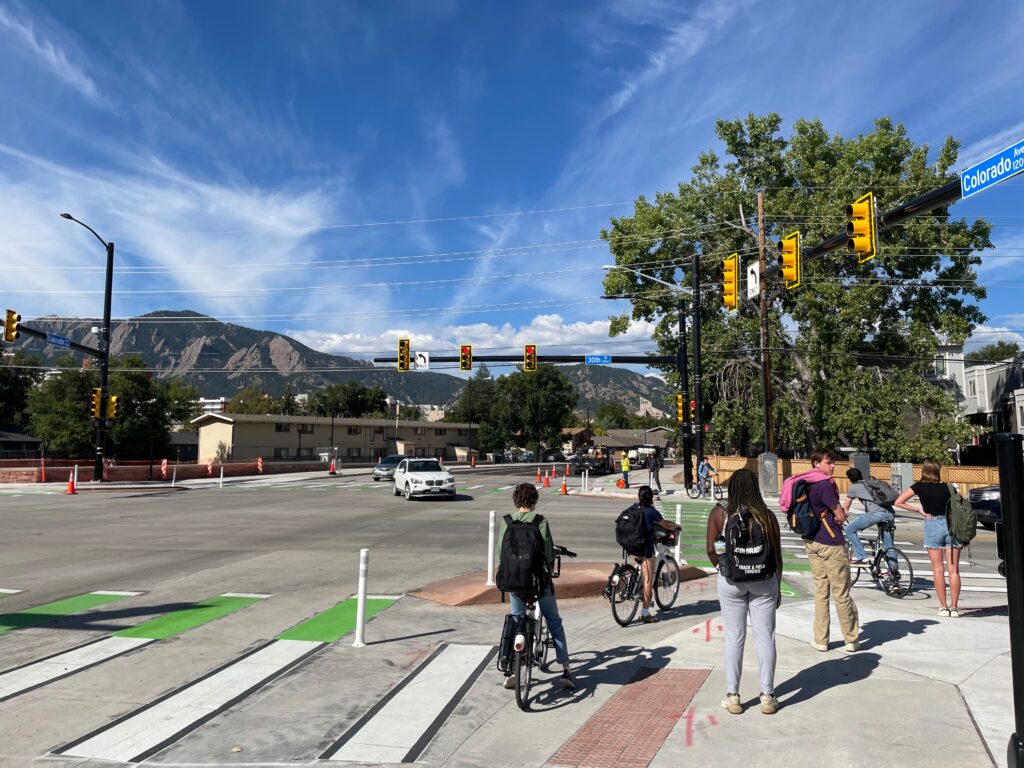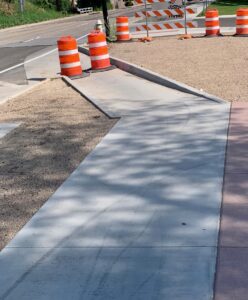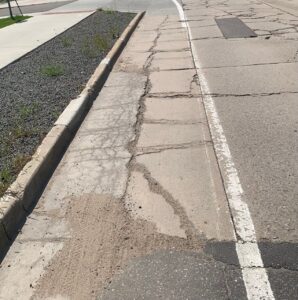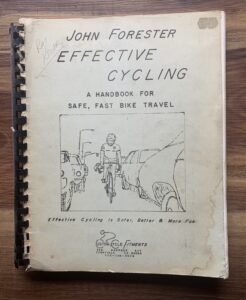Guest opinion: Boulder’s first fully protected intersection inspires celebration, caution

Friday, Sept. 15, 2023
By Ray Keener
Special to Boulder Beat
30th and Colorado changes may increase cyclist safety, but Boulder Beat bike correspondent Ray Keener remains wary of students and scooters
While the ribbon-cutting won’t happen until October 3 and the gates blocking the underpasses have yet to open, the new 30th and Colorado Protected Intersection and Underpass project has been at least partially open for two months at sidewalk level.
The full upgrade of 30th Street north to Arapahoe Avenue won’t be completed until 2024, but what exists today represents state-of-the-art traffic engineering. But this bike correspondent is not altogether pleased — and I bet other hardcore commuters would agree.
Construction for the project began in March 2021. The total project cost is $15.9 million, half of which came from the City of Boulder. The University of Colorado kicked in $3.2 million, and the feds gave $4.75 million in Transportation Improvement Program funds via the Denver Regional Council of Governments.
City Council and staff targeted this intersection for improvement due to current high traffic and crash volume.
“The 30th Street and Colorado Avenue intersection is a top collision location in the city,” Senior Transportation Planner John McFarlane wrote in response to emailed questions. “Between 2012-2022, 168 crashes took place at the intersection, 26 involving people biking,”
“These numbers of crashes are concerning because this intersection sees high volumes of people driving, biking, walking, rolling and taking transit daily,” McFarlane wrote. “Before construction, 30,000 cars, 1,500 people walking and biking, and 1,300 people riding transit traveled through the intersection in a typical day.”
The protected intersection will physically separate people walking, biking and rolling from vehicles and provide more opportunity for these road users to see and be seen by drivers.
“People will also have the option of using the new underpasses as part of the project,” McFarlane wrote, “further promoting safe travel through the intersection.”
Another factor in choosing Colorado and 30th for improvement is the anticipated growth in traffic to the East campus east of 30th Street.
“CU forecasts significant growth and development in the project area, which will result in more students traveling through this intersection,” McFarlane wrote. ”In addition, the Boulder Valley Comprehensive Plan also forecasts growth in the area.”
If you haven’t cycled through the revamped intersection on 30th Street headed either north or south, you might be surprised at first to be diverted from the previous striped bike lane onto a vertically separated sidewalk-level path.
“Several plans and initiatives have identified this bike lane design for 30th Street,” wrote McFarlane. “As part of the 30th and Colorado Corridors Study, the city engaged the community on design changes to both 30th Street and Colorado Avenue to improve travel and safety for all road users. That process identified vertically separated bike facilities due to the existing traffic volumes and 35 mph speed limit, which creates a high-level of stress for people biking.”
As far as the east-west underpasses, we haven’t seen them yet, and they will be of little interest to bike commuters trying to get from A to B with minimal diversion. Students may be more inclined to use them as they align with trips on Colorado Avenue between CU Main and East campuses.
Wrote McFarlane: “We anticipate a fair share of bicyclists and pedestrians using the underpasses since it is completely separated from vehicle traffic and may be more convenient than traveling through the intersection, such as when there are a lot of people queuing at the corner islands.”
Every time we in Boulder are blessed with new bike facilities, I celebrate. As a lifelong cyclist and bike commuter, the great routes, lanes and paths we enjoy in Boulder are essential to my quality of life.
In the course of my bike industry work, I keep close tabs on what’s being built across the U.S. and how Boulder compares. The bike industry’s decades-long push for more facilities and more safety has had a startling effect on cities large and small, which has only accelerated post-pandemic.
I don’t have the expertise to evaluate plans before they turn into facilities. In Boulder, that’s the purview of the Community Cycles Advocacy Committee, managed by CC’s Membership Director Alexey Davies. The Advocacy Committee has often been a harsh critic of the city’s projects.
“There was lots of heated debate back around the time of the [2014] Folsom Street ‘right-sizing,’” Davies said. “Now, our advocates are definitely more collaborative with the city.”
CC did not support the underpasses because of the cost compared to the perceived benefit.
“We do fully support the protected intersection at street level,” said Davies. “It’s not just about safety, it’s more about encouraging people to bike. If it feels unsafe, people won’t ride.”
Community Cycles Executive Director Sue Prant is also enthusiastic about the bike facility design and the city and CU’s implementation.
“A protected intersection has a slight learning curve,” she said, “but they are fairly intuitive. From the designs, the city appears to be building the intersection using the recommended implementation guidance.”
“I think this, along with planned improvements for protected bike lanes on 30th Street, will greatly improve the safety of this important north/south corridor,” Prant said. “With the success of this intersection, I hope we can see other dangerous intersections be rebuilt with greater safety for all users.”
While I rely on CC’s expertise to look out for my interests as a cyclist, I do have opinions based on over three decades of regularly riding the 30th Street corridor. One glaring shortcoming of the revamped intersection occurs where the new 30th Street sidewalk-level path reconnects with the street level. I call it “the funnel” .

When you’re headed north on 30th and you’ve crossed Colorado, “the funnel” is two raised curbs at about a 30-degree angle to your direction of travel that puts you back out onto the existing 30th Street bike lane. My first time through, I thought, ”I hope no one bounces off either of these curbs; they may end up out in the car lanes.”
In the next few weeks, interim changes will be made to the northbound bike lane transition to better merge the sidewalk-level and on-street bike lanes and more clearly mark the vehicle lane from the on-street bicycle lane, the city says.
In the meantime, be careful the first time through here, especially at night, since the lighting is poor. And beware of the existing nasty cracks in the bike lane about 20 yards farther north of “the funnel.” I guess they can’t fix all the problems at once.

My other reaction to the 30th and Colorado improvements could be described as “congenital skepticism.” Back in the 1970s, I and many other daily commuters were disciples of John Forester and his seminal work on riding a bike in traffic called “Effective Cycling.” The premise was to eschew “safer” bike facilities that separate you from the stream of traffic, and behave in traffic just like cars do to avoid confusion.

Forester would disapprove of modern bike facility design just as vehemently as he did back in the ‘70s. The way the new bike path takes you out of the flow of traffic and forces you to zig and zag through the intersection — in close proximity to other cyclists and pedestrians — would have been anathema to Forester and disciples, including me.
And as much as I will grumble a bit by being forced to slow down and slalom through students for the sake of perceived (if not actual) safety, I also won’t be (legally) riding through the intersection in the traffic lane as Forester would surely have done (and some Boulder hard-core cyclists may choose to do).
I consider it severely bad form for cyclists to ride in the traffic lane when there’s a bike facility available along the same route. Car drivers don’t understand the challenges we bike commuters face, and I doubt that many of them have studied “Effective Cycling.” All they know is there’s a $13 million bike facility RIGHT THERE, and I’m not using it. That makes them angry, and angry drivers are dangerous drivers.
Prant, who probably commutes more miles in a year than I do, agrees.
“Personally, I would not ride in the car lane just to save a few seconds,” she said.
While many are celebrating progress, I remain a many-seconds-wasted and many-scooters-dodged skeptic. I’ll be glad to change my mind after 100 or so uneventful test trips up and down 30th Street.
I hope to see you at the October 3 ribbon cutting. In the meantime, ride safely and wear your helmet!
If you go:
30th and Colorado Ribbon Cutting
Tuesday, October 3
11:30 a.m. Walking and biking tours depart from Scott Carpenter Park (1505 30th Street)
Noon: Ribbon cutting at northeast corner of 30th + Colorado intersection
Learn more
— Ray Keener opened a bike shop in 1975 and has enjoyed many industry roles since. He is currently Retail Editor of Bicycle Retailer magazine/website and manages projects at PeopleForBikes. Locally, he volunteers with Community Cycles and does bike fits on Saturday mornings.
Got a different take? Email it to boulder.beat.editorial@gmail.com
Want more stories like this, delivered straight to your inbox?
Opinion Transportation bike lane Boulder city council city of Boulder Community Cycles CU cycling DRCOG east campus Effective Cycling main campus pedestrians protected intersection traffic corridors traffic engineering transportation travel lane underpass University of Colorado
Sign up for a weekly newsletter from Boulder Beat.
Opinion Transportation bike lane Boulder city council city of Boulder Community Cycles CU cycling DRCOG east campus Effective Cycling main campus pedestrians protected intersection traffic corridors traffic engineering transportation travel lane underpass University of Colorado


Excellent; really glad this got done! Although I agree the underpass cost a fortune and was not required.
And with deserving respect to Ray, and appreciating the museum-worthy “Effective Cycling” pamphlet, conditions in 1976 do not inform us in 2023. Separate bike lanes are simply terrific. I recently rented a bike in Copenhagen – 650,000 bikes to 520,000 humans! – and everyone is happy in their separate lanes.
The above comment was from Buzz Burrell. Reminder to Buzz (and everyone): Please use your full first and last name to comment. Otherwise, they will be deleted. Thank you. – Shay Castle
Buzz, thanks for expressing your opinions on separate bike lanes. A few facts for you:
• The two major cycling education courses offered in the U.S., Smart Cycling (through the League of American Bicyclists and their network of League Cycling Instructors) and the similar CyclingSavvy course, are based almost exclusively on the principles put forth by John Forester. So contrary to your opinion, the principles DO continue to inform us in 2023.
• Forester’s Effective Cycling manuscript contains over 200 pages, hence not what I would call a pamphlet.
• Sometimes, “museum-worthy” ideas that have stood the test of time deserve our respect and attention. See: U.S. Constitution, Copernicus, or the Bible, depending on your spiritual bent.
• While as I said in the piece, I will stick to the separate lane provided on 30th Street, your contention that “everyone is happy” in separate lanes that impede their progress with no demonstrable increase in safety is simply not true.
• Someone said, “You are entitled to your opinion, you are not entitled to your own set of facts.”